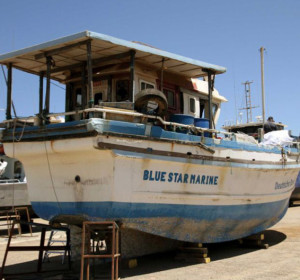Asylum seeker boat an important piece of recent history
A 45-foot fishing boat that carried 66 asylum seekers on a perilous voyage across the Indian Ocean is to become a new exhibit at one of Australia’s leading maritime museums.
Curators from the Western Australian Museum have started examining the small fishing boat that shocked authorities when it arrived off Geraldton, in WA, in 2013.
And new details about the difficulties faced by asylum seekers on such journeys are emerging from the study.
Amazed onlookers watched as the ship pulled up in front of a waterfront cafe, before the Sri Lankan asylum seekers on board were taken into custody by immigration authorities after 44 days at sea.
More than two-and-a-half years later, curators are painstakingly cataloguing every item left behind on the boat, which remains in Geraldton.
“There are children’s clothes and toys, women’s clothing, men’s clothing,” said Head of Maritime History at WA Museum, Sally May.
“There were bedspreads that were used on either side of the port side of the wheelhouse, which was obviously a toileting area.”
Ms May is one of two curators working on the vessel to piece together the story of what it was like on board.
“They obviously accommodated women in privacy but I think it would have been … very hard conditions to be at sea,” she said.
“You know, 66 people, very few of them being able to get cover,” she said.
Almost 1,000 sealed bottles remain on the boat along with bags full of tonnes of salt, which were believed to be used for ballast.
Bottles with what appeared to be urine were also found on board.
“Possibly they thought they might run out of water, so they were conserving their urine for reuse if they did run out of water,” Ms May said.
Those on board had planned to travel to New Zealand, but ran into trouble along the way. An examination of the boat’s exterior found a large amount of rope wrapped around its weary propeller – likely to be what cut the journey short.
“They’ve probably run over rock lobster pots and that’s wrapped around the propeller, and the propeller blades, and that’s what’s made the vessel lame and why it basically limped into Geraldton,” Ms May said.
The researchers plan to talk to the passengers to find out first-hand what the experience was like.
The tuna fishing boat was one of four gifted to the Sri Lankan fishing community after the 2004 Tsunami.
Ms May said the boat was built to accommodate five people.
“I don’t think you would ever contemplate wanting to do it yourself … it would have been horrific, awful,” she said.
“You couldn’t shower, there wasn’t enough water for showering, and 66 people for 44 days … it was very severe and austere.
“It gives you a great deal of sympathy for them.
“For them to take such huge risks with their own lives and to have women and children — it really just makes you sort of wonder what drove them to really put their lives at risk.
“Because seriously, their lives were at risk on this boat,” Ms May said.
The boat is one of only a few asylum seeker vessels in the nation to be preserved by a museum; an important piece of contemporary history.
The boat will be trucked to Perth for further conservation work and decision is to be made on where it will eventually be displayed.
Laurie Nowell
AMES Australia Senior Journalist













